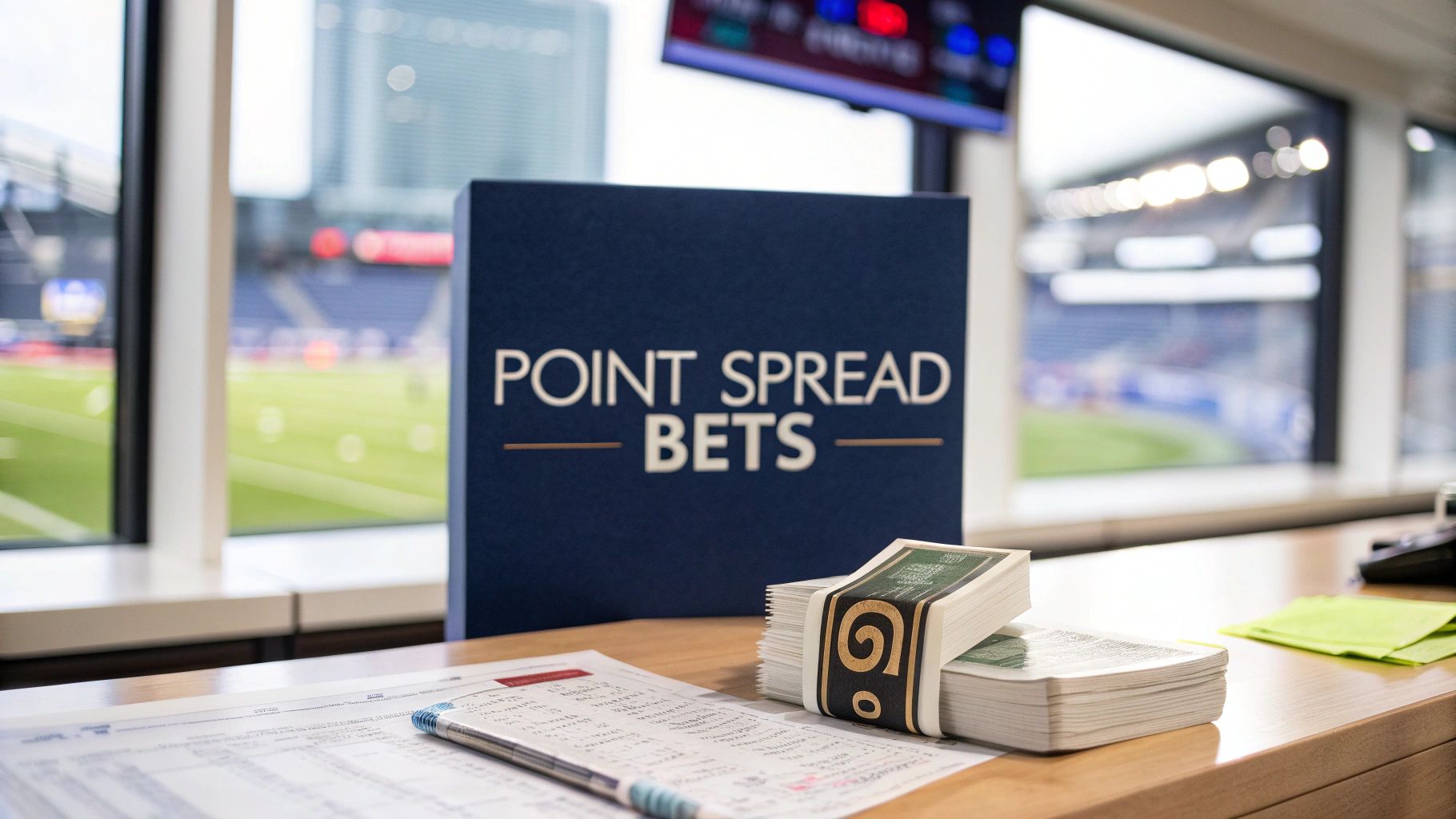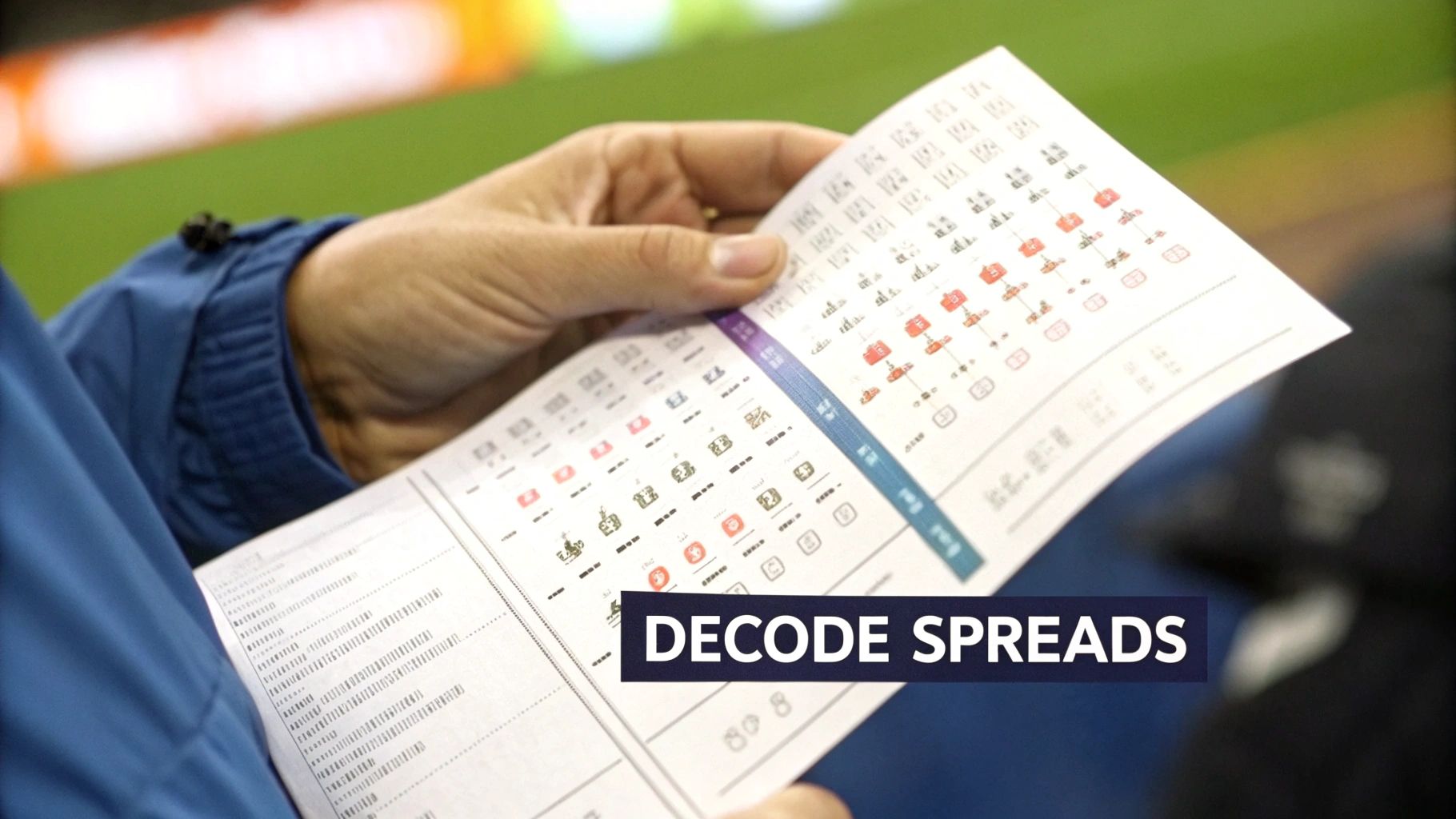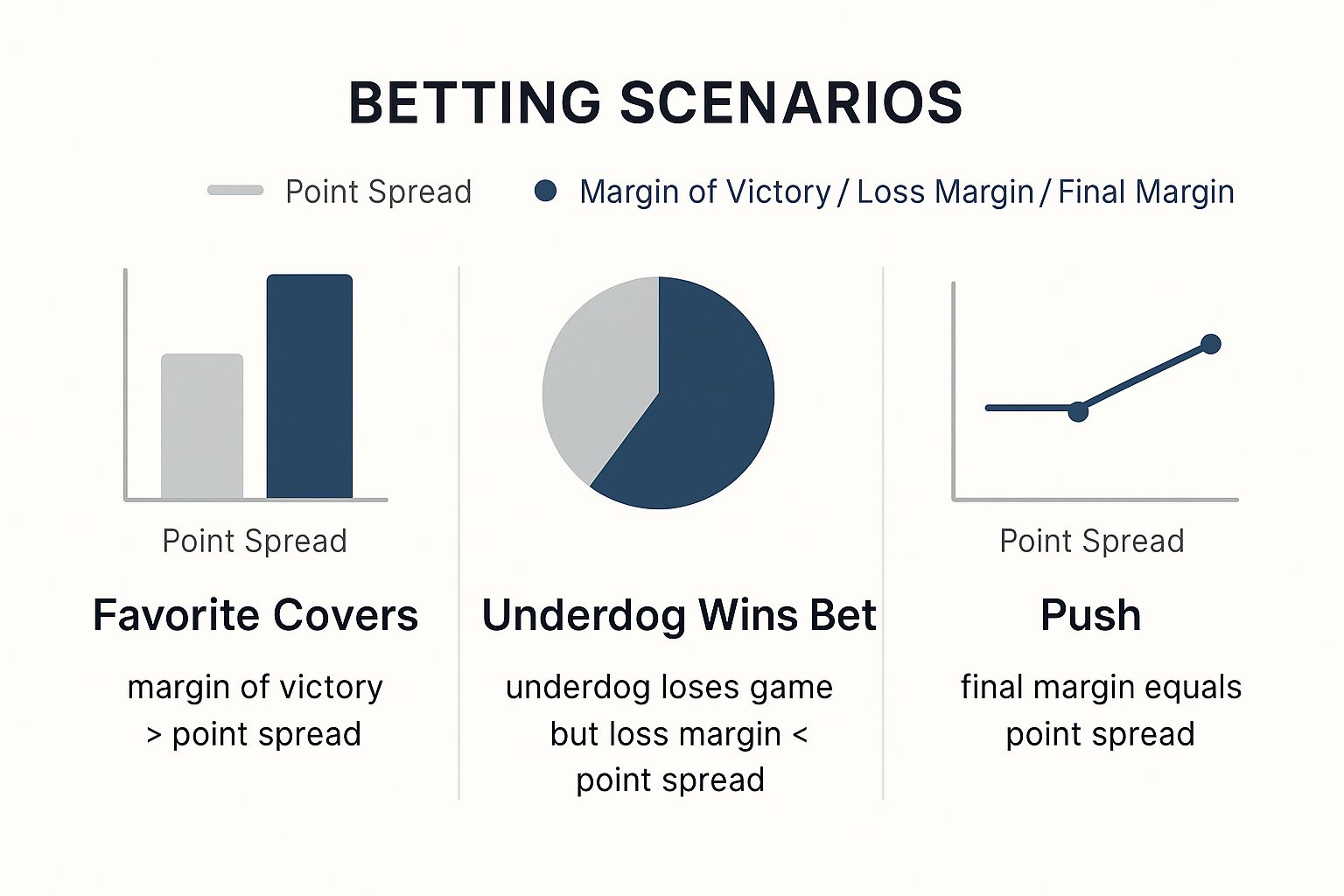
A Bettor's Guide to Point Spread Bets
Master point spread bets with our expert guide. Learn how to read odds, analyze matchups, and build a winning betting strategy that gives you an edge.
Point spread bets are all about evening things up. Instead of just picking a winner, they create a more balanced contest by giving the underdog a virtual head start before the game even begins. It's not about who wins, but by how much. This simple twist turns even the most lopsided matchup into a genuinely competitive betting opportunity.
What Are Point Spread Bets in Simple Terms

Think of it like a friendly race between a pro sprinter and an amateur. To make it interesting, you'd give the amateur a head start, right? That's exactly what a point spread does. Sportsbooks set a number that acts as a handicap, representing the expected margin of victory for the better team.
This completely changes how you look at a game. You're no longer just asking, "Who will win?" Instead, you're analysing how a team will perform against expectations. It’s all about the margin.
Favourite vs Underdog
Every spread bet has two sides, and you have to pick one.
- The Favourite: This is the team everyone expects to win. You'll spot them by the minus sign ( - ) next to their spread number, like -6.5. For your bet to cash, they have to win the game by more than that number.
- The Underdog: This is the team expected to lose, marked with a plus sign ( + ), like +6.5. Here’s where it gets interesting. To win this bet, the underdog can either win the game outright or just lose by less than the spread.
This is the magic of spread betting. A team can get crushed on the scoreboard but still make you a winner by putting up a good fight and covering the spread.
Key Takeaway: A point spread isn't a prediction of the final score. It’s a handicap created by bookmakers to get roughly equal money bet on both teams. The goal is to turn any game into a 50/50 proposition for bettors.
To help you get comfortable with the terminology, here’s a quick breakdown of what you'll see on the betting line.
Point Spread Bet at a Glance
| Term | What It Is | Example |
|---|---|---|
| Favourite | The team expected to win; must win by more than the spread. | New England Patriots -7.5 |
| Underdog | The team expected to lose; must win or lose by less than the spread. | New York Jets +7.5 |
| The Spread | The number of points used as a handicap to balance the odds. | The number is 7.5 in this case. |
| Juice / Vig | The sportsbook's commission, usually shown as -110. | Bet €110 to win €100. |
Now you can see how all the pieces fit together to form a single bet.
The Role of Juice or Vig
Speaking of that -110 number, that’s the sportsbook’s cut, often called the "juice" or "vig." It's the fee they charge for taking your bet. At -110 odds, you need to risk €110 just to win €100. This small commission is how the house guarantees it makes a profit over the long run, no matter who wins.
While point spread betting is huge in sports like American football and basketball, its popularity varies. Here in Romania, it’s usually called 'handicap betting' and often takes a backseat to more traditional wagers. Football is king, and most local punters stick to the classic 1X2 (win-draw-win) or over/under goals markets. If you want to see how this plays out in the Superliga, you can find more insights on Romanian football betting at OddsPortal.com.
By understanding these core concepts—the favourite, the underdog, and the juice—you’ve got the foundation you need to start placing smarter point spread bets.
How to Read Point Spreads Like a Pro

Staring at a betting line for the first time can feel like trying to crack a code. All those numbers and symbols look confusing, but trust me, it’s a simple language once you get the hang of it. Let's walk through a real-world example and turn that jumble of numbers into knowledge you can actually use.
Picture this line for an upcoming football match:
- Manchester City -1.5 (-110)
- Everton +1.5 (-110)
Everything you need to know about the matchup and your potential bet is right there.
The Signs Tell the Story: Minus vs. Plus
The first thing your eyes should jump to are the plus ( + ) and minus ( - ) signs. These are your instant identifiers for the favourite and the underdog. Simple as that.
- Manchester City -1.5: That minus sign immediately flags them as the favourite. For a bet on City to cash, they need to win the match by more than 1.5 goals. A 2-0 win? You’re golden. But a tight 1-0 victory means your bet loses.
- Everton +1.5: The plus sign marks them as the underdog. Here’s where it gets interesting. A bet on Everton wins if they pull off the upset and win outright, or if they lose by just one goal. That +1.5 is your safety net.
This is the core of handicap betting. In Romania, for example, many punters stick to the familiar 1X2 bets (home win, draw, away win), especially for football. But getting comfortable with point spreads opens up a whole new layer of strategy. With online betting user penetration still around 10-12%, there's a huge opportunity for bettors to get an edge by understanding these more advanced markets.
A Bettor's Best Friend: The Half-Point See that little .5 at the end of the spread? That's your best friend. It makes a 'push'—a tie where your stake is refunded—impossible. Since a team can't score half a goal, your bet is guaranteed to be a winner or a loser. No ambiguity, just a clear result.
Understanding the -110 Odds
Okay, so what about the number in the parentheses, usually -110? Think of this as the price tag on your bet. It's what the industry calls the 'juice' or 'vig', and it tells you how much you stand to win.
The standard -110 means you have to risk €110 to win €100. If your bet hits, you get your original €110 stake back plus your €100 profit, for a total payout of €210. It’s essentially the small commission the sportsbook charges for taking your action. These odds are fundamental to betting, and you can dive deeper in our guide on how to read betting odds.
Once you can quickly interpret these three pieces—the signs, the spread number, and the juice—you’ll be able to look at any betting line and know exactly what needs to happen to make your bet a winner.
Point Spread Bets in Action with Real Examples
Theory is one thing, but seeing how a point spread bet plays out in a real game is where it all clicks. Let's walk through a classic football matchup to really get a feel for how these bets are won and lost.
Picture this betting line for an upcoming game:
- Syracuse Orange -6.5 (-110)
- UConn Huskies +6.5 (-110)
Right away, we know Syracuse is the favourite. The bookies expect them to win by at least a touchdown. UConn, on the other hand, is the underdog, so they're getting a 6.5-point head start before the game even begins.
Let's see how this could shake out.
Scenario 1: The Favourite Covers the Spread
This is the outcome the oddsmakers predicted. Syracuse comes out strong and wins comfortably.
- Final Score: Syracuse 31, UConn 20.
- Margin of Victory: Syracuse wins by a solid 11 points.
- Betting Outcome: Since Syracuse won by more than the -6.5 spread they needed to cover, a bet on them is a winner. Simple as that.
In this case, the favourite not only won the game but did so by a large enough margin to make their backers happy. They "covered the spread".
Scenario 2: The Underdog Beats the Spread
Now, let's imagine a different story. What if UConn puts up a tougher fight than anyone expected?
- Final Score: Syracuse 24, UConn 20.
- Margin of Victory: Syracuse still gets the win, but only by 4 points.
- Betting Outcome: Here's the magic of point spread betting. Even though UConn lost on the scoreboard, their 4-point loss is smaller than their +6.5 point cushion. That means a bet on UConn is a winner.
This is exactly why so many bettors love the spread. It’s not just about picking the winner; it's about correctly predicting the flow of the game. You can cash a ticket on the losing team if you correctly guessed they’d keep it close.
The infographic below helps visualise how the final score and the point spread work together to decide the winner.

As you can see, the final margin of victory is what truly matters. It's not just about who won, but by how much.
To make this even clearer, let's look at a few more possible outcomes for a different spread, say -3.5 for the favourite and +3.5 for the underdog.
Winning and Losing Bet Scenarios
| Final Score | Bet on Favourite (-3.5) | Bet on Underdog (+3.5) |
|---|---|---|
| Favourite 28, Underdog 24 | Loses (Wins by 4, but that's not enough to cover -3.5) | Wins (Loses by 4, which is within the +3.5 cushion) |
| Favourite 30, Underdog 20 | Wins (Wins by 10, easily covering the -3.5 spread) | Loses (Loses by 10, far outside the +3.5 cushion) |
| Underdog 21, Favourite 20 | Loses (Loses the game outright) | Wins (Wins the game outright) |
This table shows just how dynamic point spread betting can be. The same team can win the game, but your bet on them could either win or lose depending on that final margin.
Scenario 3: What is a Push?
You've probably noticed the .5 in our examples. There’s a good reason for that. What happens if the spread is a whole number, like Syracuse -7?
- Final Score: Syracuse 27, UConn 20.
- Margin of Victory: Syracuse wins by exactly 7 points.
- Betting Outcome: This result is a push. The final margin landed perfectly on the spread. When this happens, it's a tie. The sportsbook simply refunds everyone's original wager. No one wins, no one loses.
This is precisely why sportsbooks love using those half-points. A line like -6.5 guarantees a clear winner and loser, eliminating the possibility of a push.
Understanding these scenarios is key for any bettor. Here in Romania, the legal framework for sports betting is quite broad, and it certainly covers point spread (or handicap) wagers. However, the National Gambling Office doesn't release detailed reports on specific wager types, so it's tricky to say just how popular spreads are compared to other bets. If you want to dive deeper into the local rules, you can read more about Romanian gambling regulations on Mondaq.com.
By mastering these real-world examples, you're building the foundation needed to analyse games with a much sharper eye.
Key Factors to Analyse Before You Bet the Spread

Knowing what a point spread is and actually making money from it are two very different things. The real skill isn't just reading the line; it's building a repeatable process for breaking down a matchup. If you want to make smart bets, you have to move past gut feelings and start looking at the cold, hard factors that determine if a team can actually cover.
It’s all about digging into the data and understanding the context behind the numbers. Remember, the oddsmakers have already priced in all the obvious information. Your job is to find the angle they’ve overlooked or undervalued. This disciplined approach is what separates the casual punter from the sharp, long-term winner.
Go Beyond the Win-Loss Record
A team’s record tells you who won, but it tells you nothing about how they won. Think about it: a team that’s 5-0 after squeaking by with a single-point victory each week is worlds apart from a 5-0 team that’s been blowing out opponents by an average of 20 points. When you’re betting the spread, that context is everything.
This is why you need to look at a team's performance Against the Spread (ATS). This single metric reveals how often a team is beating the market's expectations. You might find a team with a losing record is an ATS goldmine simply because they consistently keep games much closer than everyone predicts.
Pro Tip: Don't stop at the overall ATS record. Dig deeper. Check out their home vs. away splits and how they perform as a favourite versus an underdog. Some teams crumble under the pressure of being a favourite, while others thrive on being underestimated.
Assess Team Form and Health
Recent performance is almost always a better indicator of a team's current ability than what they did back in week one. Is a team riding a three-game winning streak with an offence that can't be stopped? Or are they in a slump, struggling to put points on the board? Momentum is a real, tangible force in sports.
Injuries are another game-changer. The absence of just one key player—a star quarterback, a shutdown cornerback, a dominant centre—can completely flip a game’s dynamics and swing the spread by several points. Make it a habit to check the final injury reports right before you place your bet. For a more detailed breakdown, our guide on tactical matchup analysis offers deeper insights into evaluating team strengths and weaknesses.
Key Analytical Factors to Consider
Before locking in your bet, run through a quick mental checklist. Each of these variables adds another piece to the puzzle, helping you build a stronger case for your wager.
- Head-to-Head History: Do certain coaches or schemes just have another team's number? Some rivalries have deep psychological elements that stats alone will never capture.
- Travel and Fatigue: A team playing its third consecutive road game is at a massive disadvantage against a well-rested opponent coming off a bye week at home. That cross-country travel takes a serious toll.
- Offensive and Defensive Efficiency: Look beyond total points and yards. Dive into metrics like points per possession or yards per play. A hyper-efficient offence is built to cover big spreads, while a lockdown defence is perfect for keeping a game close as an underdog.
By systematically working through these factors, you start building an evidence-based argument for your bet. That’s how you find a real edge over the average bettor.
Advanced Betting Strategies and Common Mistakes
Alright, you’ve got the basics down. Now it’s time to start thinking like a sharp. Consistently winning at point spread betting isn’t about luck—it’s about discipline, a solid strategy, and steering clear of the common traps that snag most casual bettors.
The real difference between turning a profit and going broke often boils down to the small edges you can find and the costly mistakes you learn to sidestep. Successful bettors have one thing in common: they think like an investor, not a fan. They hunt for value, manage their money with an iron fist, and never let emotion get in the way of a good decision.
Profitable Point Spread Strategies
Adopting even one of these pro-level techniques can make a huge difference to your bottom line. The game is all about finding small, consistent advantages that stack up over the long haul.
Shopping for the Best Line: Never, ever place a bet at the first sportsbook you check. Different bookmakers will almost always have slightly different spreads. Finding a -6.5 line when everyone else is offering -7 is a massive win that sharp bettors cash in on every single day. That half-point is often the difference between getting paid and pushing.
Fading the Public: The "public" is just a term for the majority of casual bettors. These are the folks who tend to bet with their hearts, backing popular teams, big names, and recent winners. When you see that 80% or more of the bets are flooding in on one side, the line can get artificially inflated. Betting against that wave—or "fading the public"—is a classic contrarian move that can uncover huge value on the underdog.
Buying Points: Some sportsbooks give you the option to move the spread in your favour, but it’ll cost you. For example, you could "buy" half a point to shift a spread from -3 down to -2.5. This turns a potential push into a win if the team wins by exactly three. It’s a powerful tool if you use it smartly, especially around key numbers in football like 3 and 7, where so many games are decided.
Common Mistakes to Avoid
Knowing what not to do is just as crucial as knowing what to do. Too many bettors sink their own ship by falling into the same predictable traps. Avoiding these is fundamental to staying in the game long enough to profit.
The single most dangerous mistake? Terrible bankroll management. This means betting way too much of your total funds on a single game. A disciplined bettor rarely risks more than 1-3% of their bankroll on any one wager. This ensures that one bad beat or an unlucky streak doesn't wipe you out completely.
Key Insight: The goal isn't to win every single bet. It's to have a structured plan that helps you survive the inevitable losing streaks and capitalise on the hot ones. Without solid bankroll management, even the most brilliant betting strategy is destined to fail.
Another classic blunder is overreacting to what just happened, a trap known as recency bias. A team is rarely as good as its last amazing win or as dreadful as its last blowout loss. Instead of focusing on last week, you need to dig deeper into their performance metrics over the entire season. Looking at the bigger picture helps you spot genuine value bets and anticipate odds movement before the rest of the market jumps on board.
By combining these smarter strategies with a disciplined effort to avoid common errors, you start to tilt the odds back in your favour. It's this methodical approach that separates a few lucky wins from long-term, sustained profitability.
Point Spread FAQs: Your Questions Answered
Even when you've got the basics down, a few tricky questions always seem to pop up. Let's run through the most common ones I hear, so you can feel completely confident before you put your money down.
Think of this as your go-to guide for those "what if" moments every bettor runs into. Nailing these details is often what turns a hopeful punt into a smart, well-reasoned bet.
What Happens If the Bet Is a "Push"?
A push is just industry-speak for a tie. It happens when the favourite wins by the exact number of the point spread. Say the spread is -7, and the favourite wins by exactly seven points – that’s a push.
When this happens, the bet is cancelled. The sportsbook simply returns your original stake. You don’t win anything, but critically, you don’t lose anything either. It’s a do-over. This is precisely why you'll often see spreads with half-points (like -7.5). That half-point makes a push impossible, guaranteeing a winner and a loser.
Is a Point Spread a Better Bet Than a Moneyline?
One isn't automatically "better" than the other; they're just different tools for different jobs. A moneyline bet is as simple as it gets: you're just picking which team will win the match, full stop. The final score doesn't matter.
A point spread, however, is all about how a team performs against expectations. This offers a couple of big advantages:
- Better Value on Favourites: If you’re convinced a top team will not just win, but win big, the spread gives you much more attractive odds than a moneyline wager.
- A Fighting Chance for Underdogs: You can back the underdog and still win your bet even if they lose the match, provided they lose by fewer points than the spread.
It all boils down to where you think the real value lies in any given match.
Key Insight: Go for a moneyline when you smell an upset or think it’ll be a nail-biter. Choose the point spread when you have a strong feeling about the margin of victory, not just who will get the win.
Why Do the Spreads Change Before Kick-Off?
Point spreads are living things; they don't stay put. They move for two main reasons. The biggest driver is simply the amount of money being bet. If a flood of cash comes in on one side, the bookmakers will shift the line to make the other side more appealing. They want roughly even money on both outcomes to minimise their risk and lock in a profit.
The other reason is new information hitting the street. This could be a last-minute injury to a star player, a sudden change in the weather forecast, or any other bit of news that could realistically alter how the match plays out. Watching why a line moves can give you a fascinating glimpse into what the market and the sharps are thinking.
What Does the -110 Number Next to the Spread Mean?
That little number is the sportsbook's commission, often called the "juice" or the "vig". For point spread bets, -110 is the industry standard.
It simply means you need to bet €110 to win €100 (getting back €210 in total). That small, built-in margin is how bookmakers make their money over time. You might sometimes see it shift to -105 or -115, but -110 is what you should expect to see most of the time.
Ready to turn these insights into action? OddsHaven uses AI to analyse thousands of data points, delivering daily high-confidence picks and parlay suggestions for top football leagues. Stop guessing and start making data-driven decisions at https://www.oddshaven.ai.
Ready to Start Winning?
Join OddsHaven and get instant access to AI-powered predictions with an 87% win rate on high-confidence picks
Try OddsHaven Free for 5 Days

